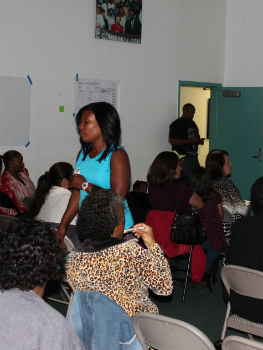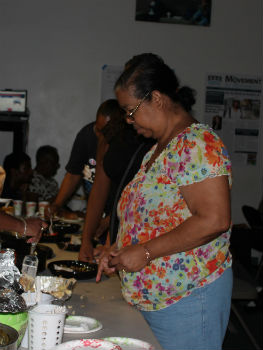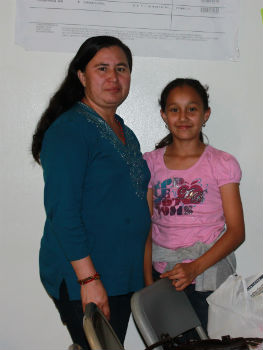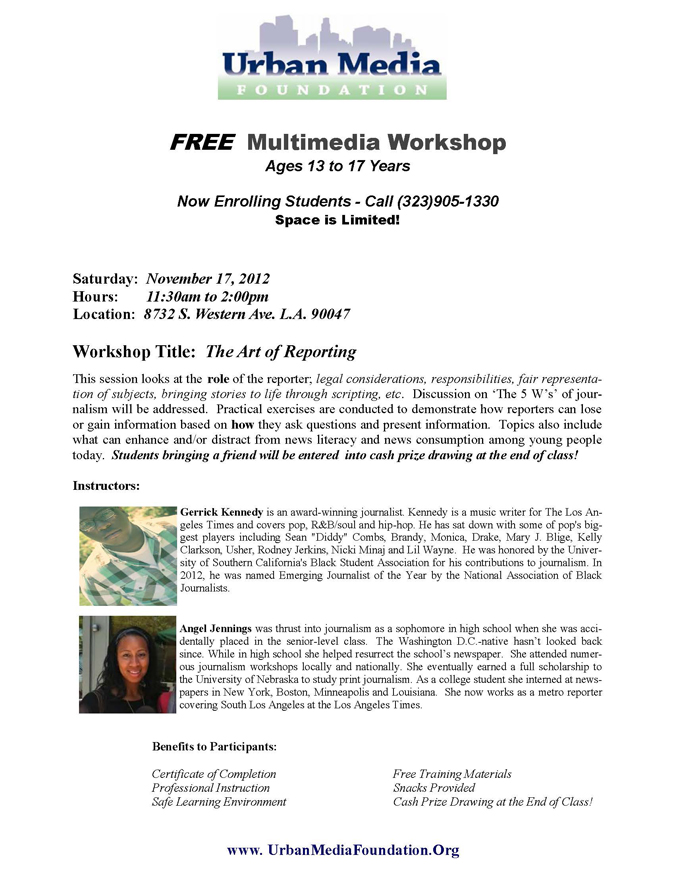
Reconstitution at Crenshaw High School
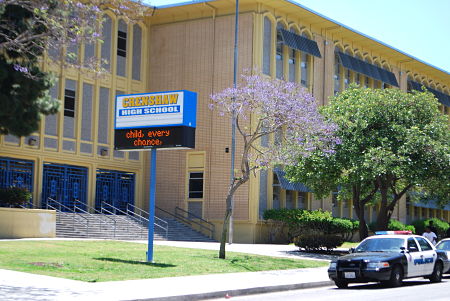 LAUSD Superintendent John Deasy’s letter, dated October 23, 2012, ordered Crenshaw Senior High School to come under the direct supervision of LAUSD’s Intensive Support and Innovation Center, “effective immediately.” Citing “four years of…less than adequate progress in….several key indicators,” Deasy informed the school that it would be divided into three magnet schools with increased AP courses and International Baccalaureate pathways. All teachers and administrative staff would have to reapply for the school’s relaunch on July 1, 2013.
LAUSD Superintendent John Deasy’s letter, dated October 23, 2012, ordered Crenshaw Senior High School to come under the direct supervision of LAUSD’s Intensive Support and Innovation Center, “effective immediately.” Citing “four years of…less than adequate progress in….several key indicators,” Deasy informed the school that it would be divided into three magnet schools with increased AP courses and International Baccalaureate pathways. All teachers and administrative staff would have to reapply for the school’s relaunch on July 1, 2013.
Sylvia Rousseau, former interim principal at Crenshaw High and now a professor in USC’s Rossier School of Education, says the Superintendent has a point. “Clearly, it has to be acknowledged that the school has not performed at the level that it needs to perform,” said Rousseau.
A program called Extended Cultural Learning was partially implemented at Crenshaw in 2011-2012, after some disappointing results on state tests in preceding years. Since implementation, proponents say the school has met or exceeded all of California’s Academic Performance Index targets for growth except one.
Based on those results, Crenshaw successfully applied for the highly competitive School Improvement Grant, or SIG, from the Federal Department of Education and administered through the State of California. Half of all SIG applications from California were rejected. Crenshaw received $6 million dollars to continue improvements at the school. That award may be in jeopardy if the school is significantly restructured.
Furthermore, says educational scholar John Rogers of UCLA, there’s just not a lot of research supporting reconstitution. “Paradoxically, despite the fact that the federal government increasingly calls for research-based reform, there really isn’t a research base for reconstitution.” said Rogers.
Why then is reconstitution becoming increasingly popular—according to one study, up to 60 percent from 10 years earlier? “I think education reform often is driven by a desire for quick & simple & often cheap answers,” said Rogers. “Lots of people are frustrated with the slow pace of reform or by schools that are not enabling young people to achieve the goals the young people have & their communities have.”
But as Rousseau underlines, a large body of data says that kids in under-performing urban schools often don’t see the relevance of education to their lives unless it has positive effects in the surrounding community. “So the students saw the relevance and the importance between education and their own capacity to make change in their community,” she said.
And Crenshaw did this through Extended Cultural Learning. That will be replaced by three magnet schools under Deasy’s proposed revamp. Rousseau says if funding isn’t stabilized, if personnel aren’t stabilized, progress will be hard to hold on to. “Unless the district takes a comprehensive view of the needs of the students, unless we take a more humanistic approach that our students aren’t widget,” she said.
Deasy and Crenshaw High faculty and staff are due to meet after the Thanksgiving holiday. It’s not clear if reconstitution is a done deal, or if there’s still room for negotiation.
OPINION: Crenshaw High School Community Against Reconstitution
By: Christina Lewis, Crenshaw High Special Education Teacher
Irvin Alvarado, Crenshaw High Alumni, Coalition for Educational Justice Organizer
Alex Caputo-Pearl, Crenshaw High Social Justice Lead Teacher, UTLA Board of Directors
Eunice Grigsby, Crenshaw High Parent, Crenshaw High Alumna
On October 23, Superintendent Deasy announced he intends to reconstitute Crenshaw High School. This scorched earth “reform” that is destructive for students, communities and employees has been used at Fremont, Clinton, Manual Arts and more, despite courageous push-backs at those schools. 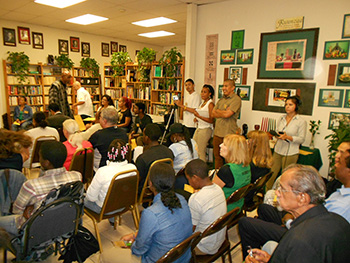
The Crenshaw school community is determined to fight back. The slogan that permeated the emergency 150-person Crenshaw Town Hall Meeting at the African-American Cultural Center on October 4 crystallizes the struggle — “Keep Crenshaw: Our School, Our Children, Our Community.”
In an attempt to disarm the push back and win public support, Deasy is combining the reconstitution with a full-school magnet conversion. Crenshaw stakeholders are, of course, open to conversations that will improve conditions and outcomes for our students — but those must be collaborative and well-resourced. That said, it is clear that Deasy’s main objective is not magnet conversion – it is to take top-down control of the school and reconstitute (which means removing all faculty and staff from the school, with an “opportunity to re-apply”).
The school community says NO to any form of reconstitution, and YES to school improvement that includes stakeholders and holds LAUSD accountable for its years of neglect and mismanagement.
In this spirit, teacher, parent and administrative leaders of Crenshaw’s nationally-recognized Extended Learning Cultural model have been reaching out to Deasy to work in collaboration for over a year and a half. He has not responded. It’s clear that Deasy has cynically set Crenshaw up – persistently ignoring calls to meet when it is about something locally-developed and progressive; later, acting as if nothing is happening at the school, and dropping the reconstitution bomb.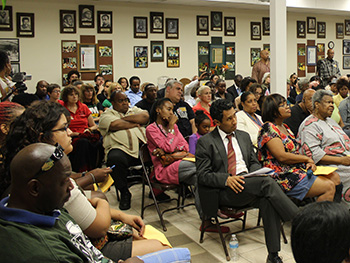
The Extended Learning Cultural model has been developed at Crenshaw over the last several years. The approach is to teach students standards-based material wedded with cognitive skills used in real life efforts to address issues at school, in the community, and with local businesses. Cultural relevance, Positive Behavior Support, parent/community engagement and collaborative teacher training and excellence are foundations of the program. Students engage in rigorous classroom work, as well as internships, job shadowing, leadership experiences, school improvement efforts and work experiences.
The Extended Learning Cultural model is fundamentally about extending the meaning, space and time of learning, and extending the school into the community and vice versa. This rooting of learning into a context is essential for students who have been constantly uprooted and destabilized by economic injustice and a school system that focuses on narrow test-taking rather than cultural relevance. Extended Learning could be enhanced dramatically for our students with LAUSD support. Instead, by threatening it, Deasy is jeopardizing Crenshaw’s progress, outside partnerships and outside funding.
Moreover, the Extended Learning Cultural model is supported by research – it draws from the Ford Foundation and various progressive academics’ national More and Better Learning Time Initiative, and it has been developed at Crenshaw with USC, the Bradley Foundation and other nationally-recognized research partners.
In contrast, the research shows that reconstitutions are not good for students. Reconstitutions cut students off from the faculty and staff they know, from programs they are involved in and from the communities surrounding their schools. Districts reconstitute schools in working class communities of color, creating more instability and uprootedness for students who are often our most vulnerable. Reconstitutions are educational racism. For more details, see a brand new study from UC Berkeley and the Annenberg Institute at Brown University at http://nepc.colorado.edu/files/pb-turnaroundequity_0.pdf.
Extended Learning showed results at Crenshaw in its first year of partial implementation, 2011-2012, after 2 years of planning. Crenshaw dipped on some indicators between 2009 and 2011 when the school had a principal who wasn’t the first choice of the selection committee, who was imposed by LAUSD, and who did not work collaboratively. However, when the school regained focus around Extended Learning in 2011-2012, the data showed growth, including:
- Meeting all State of California API growth targets except for one, often far exceeding the targets (for example, a 92 point API gain among special education students);
- Reducing suspensions and expulsions;
- Achieving substantial growth among African-American students on the API, reaching API levels significantly higher than African-American students at many other South LA high schools;
- Achieving an explosive increase in math proficiency levels among Limited English Proficient students on the CAHSEE;
- Achieving a huge jump in proficiency levels in CST math among all 10th graders;
- Including many more students in internships and work experiences;
- Organizing more partnerships for wrap-around services for students;
- Increasing parental involvement
Yet, Superintendent Deasy wants to disrupt this trajectory of growth and reconstitute Crenshaw. Worse yet, he wants to do this without any consultation with the community, parents, students, alumni, faculty and staff. Part of his agenda is to curry favor with the national scorched earth “reform” movement. Another part is straight union-busting. He has said many times he doesn’t like the teacher union leadership at Crenshaw – many of the very leaders who have been at the forefront of building the Extended Learning Cultural model, its national connections, and the growth that has come from it.
Not surprisingly, other schools that have been reconstituted in LAUSD have undergone “re-application” and “re-hiring” processes that have been shady – unrepresentative hiring bodies, discrimination against older staff and teachers of color, and discrimination against staff based on political issues.
The Crenshaw school community has a strategy to win the push back against Deasy’s reconstitution and to win support for the Extended Learning Cultural model and other enhancements:
- Amidst Deasy’s intense destabilization efforts that affect the school daily, educators, staff, and parents are working with site administration to tighten up school operations as much as possible;
- The school community is deepening, refining, and broadening engagement around the Extended Learning Cultural model;
- Faculty and staff have strongly solidified against reconstitution internally;
- School stakeholders are building on years of work with a unique coalition of community partners to organize parents, students, alumni, and community. This coalition includes Ma’at Institute for Community Change; African-American Cultural Center; Black Clergy, Community, and Labor Alliance; Coalition for Black Student Equity; Labor/Community Strategy Center; Coalition for Educational Justice; Sierra Club; Southern Christian Leadership Conference; Park Mesa Heights Community Council; and more.
- The coalition is working closely with UTLA. The House of Representatives voted unanimously to support the Crenshaw struggle. UTLA West Area and Progressive Educators for Action (PEAC) are critical supports for the ongoing organizing.
At the moment, the organizing will focus on the two places Deasy needs to go with his destructive plan for approval – the LAUSD School Board and the California Department of Education (Deasy cannot undermine Crenshaw’s federal School Improvement Grant, SIG, without communicating with Sacramento, because the grant is administered by the State).
The Crenshaw school community knows that the eyes of the city, state, and nation are watching Crenshaw. If Deasy gets his way at Crenshaw, it further opens the door to these kinds of moves everywhere – including places he’s already attacking locally with similar reconstitution efforts, like King Middle School, and far more. On the other hand, if Crenshaw is able to organize with school and community to push back on Deasy and to further advance a deep and hopeful educational and racial justice-based reform, its reverberations will be felt incredibly widely. Keep connected to the struggle and “like” us through the Facebook page – Crenshaw Cougars Fighting Reconstitution – and be in contact with us through email at [email protected].
Flower Street residents tell the city they don’t want to go anywhere
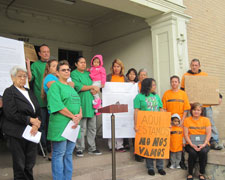
Listen to the audio story from Annenberg Radio News:
Residents of the 100-year-old apartment building at 2913 S. Flower Street are sending a letter to the city today.
“Dear Developers, City Officials, and members of the general public,
This letter is meant to express one simple intention: we will not leave our community without a fight,” the letter begins.
Many families in the 33-unit building have lived there between 15 and 35 years. But they have started to feel pressured by the growth of the neighborhood around them.
“There’s a lot of redevelopment of this area,” says Thelmy Perez, an organizer with the LA Human Right to Housing Collective. Her organization helped write the letter along with other groups LA CAN and Comunidad Presente. “You have the university to the south, you have now the proposed Farmer’s Field development that’s just north of us, you have the giant Palmer project that’s up here on the corner, you have the new Icon project that’s over here on the corner of Figueroa and Jefferson and the Metro [Expo] rail line.”
About half of the building’s residents are USC students. The low income families in the building like having students around and being part of the University community, but worry they might be asked to leave soon.
The building is managed by student rental group, First Choice Housing and owned by 424 W. Brown Road, LLC. First Choice Housing says it is not aware of the building being for sale.
Some residents say they’ve been offered money to move out though. So before any big changes happen, they have written this letter to the city and sought legal advice. Barbara Schultz is a lawyer working on the tenants’ behalf.
“Under the state’s Ellis Act a landlord is allowed to remove a unit from the market, but only if they’re going to permanently remove a unit from the rental market. They are not allowed to displace tenants only to either just replace them with new tenants or build a new building and replace them with new buildings,” Schultz says.
In October, USC agreed to contribute $20 million toward affordable housing as part of their University Village expansion project. Farmers Field reached a similar settlement with the city last week for $15 million. Until those projects begin, what will happen with those contributions is unclear.
It is clear that this neighborhood is changing quickly. Whether or not the rumors of the building’s potential sale are true, Perez says the residents want the city to know their concerns saying, “What we’re calling for is people-oriented development.”
Residents say they don’t mind changes in the neighborhood, as long as it means they don’t have to go anywhere.
New Elementary School Celebrates Opening in South LA
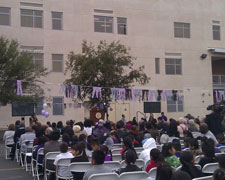
Listen to the audio story from Annenberg Radio News:
The skies were overcast, but the mood was sunny. After two years of planning and construction, the Dr. Lawrence H. Moore Math/Science/Technology Academy opened in August.
The clean-lined modernist buildings at 61st and Hooper serve 754 students, ages six-eleven. The new school helps keep classroom sizes down across the neighborhood, a fact not lost on student body president Freddy Herrera: “It is awesome that we have a new school in our area, because at the other elementary schools, it was overcrowded. Here, we don’t have that problem.”
The new academy focuses on what are known as STEM skills—science, technology, engineering, and mathematics. California Congresswoman Louise Roybal-Allard, said these skills are more critical than ever before, because “it is important to the future success of our country and our competitiveness in the world marketplace.”
A June study by Change the Equation, an organization which works to promote STEM education, said there are two jobs open for every one worker employed in science- and technology-related jobs. And those jobs are often well-compensated. Stem workers with only bachelors’ degrees often make as much as workers in other fields with advanced degrees.
A group of sixth-graders were on hand to help with the ceremonies. They were pretty happy about their new school. Jasmine Perez, 11, said it was a friendlier school than the one she’d been at before.
“In my other school, it doesn’t compare to this at all. There’s, like, many, many kids who are mean and disrespectful, and when I first came to this school, I thought, ‘I will have a happy year here.”
Sergio Castro was very clear about the pluses of the Moore Academy, saying, ”It’s easier to learn stuff here, because in the old school, I was always struggling. But here it’s way easier, you know? ‘Cause it’s quiet, and the teachers—they focus, like, they focus on the lessons a lot. In the other school, it was kind of the same, but they seem more professional [here] than the others, you know?”
And, as Jasmine pointed out, that means the kids get more attention from their teachers.
“I like this school because I have a great teacher. She’s a really rare teacher to me, because I don’t usually have a teacher who supports me and, like, pushes me, and tells me, ‘You can do this, come on! Shout-out to Ms. Grande!”
And when the kids are willing to say they actually like their school, that’s a big shout-out to the school, too.
Abrazando the Spanish language
By Patrick Thelen
Associate Editor

Photo Credit: Angela Daves Haley
Over 52 million people of Hispanic origin are currently living in the United States. By 2050, the number is expected to reach 132.8 million. This demographic transformation is clearly visible for those living in LA. According to the 2010 US Census, there are 4.7 million people of Hispanic origin residing in Los Angeles County. In other words, this group makes up 48.1% of the County´s population.
What exactly do these numbers mean? For Carlene Davis, an experienced policy and management professional in the public and non-profit sectors, they represent an opportunity to embrace a new reality, and confront change in a positive and enriching manner.
In 2003, as a volunteer effort in response to rising tensions from the changing racial and ethnic landscapes of Los Angeles’s schools, neighborhoods and communities, Ms. Davis founded Abrazar. Created on the premise of the unifying power of language, Abrazar –which means embrace in Spanish –is focused on utilizing Spanish-language learning as a vehicle to facilitate positive inter-group relations between African-American and Latino youth, particularly in South Los Angeles.
Although the project has been dormant during the last five years, Abrazar has just announced a community host partnership with Frederick Douglass Academy Middle School. This alliance will allow Ms. Davis’ venture to relaunch in January, 2013, the ¡Listos! After-school Program and the ¿Cómo Se Dice? Weekend Academy –the latter will be open to the general public.
The ¡Listos! After-school Program is both a Spanish-language learning and cultural awareness program for elementary school children. In Spanish, listos means both “smart” and “ready.”
The ¿Cómo se Dice? Weekend Academy is a Foreign Language Experience (FLEX) Spanish program for children between six and eleven years old. The goal is to teach Spanish in a fun way that will prepare students to acquire a second language over time.
Bridging the gap between two communities
“In the 2000’s, as the demographics of South LA were continuing to switch from African American to Latino, we started to witness an increase in black-brown tension,” says Ms. Davis. As a native of Los Angeles, she did not like what she was seeing and decided to build a bridge between both communities. She created an educational advocacy campaign, and told neighbors that their children should learn the new language.
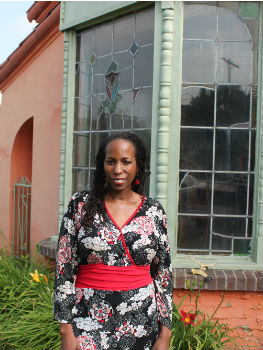
Carlene Davis, founder and director of Abrazar.
“My goal is to change the hearts of the community. Both African Americans and Latinos need to learn from each other,” says Ms. Davis. “Language is a powerful social and cultural tool that establishes bonds between diverse communities.”
“I think a program like Abrazar affects relationships between the two groups by breaking down barriers,” says Susan Plann, Professor of Chicano/a Studies at UCLA and an Advisory Board Member of Abrazar. “One of my students wrote an honors thesis on the program, and part of her research involved interviewing kids from the classes. Many said that they wanted to learn more Spanish and practiced it with their Spanish speaking neighbors. They were really into it. Programs like these demystify ‘the other’ and we need more of them.”
Abrazar started off as a vocational side job for Ms. Davis. Her full-time job was very time consuming and did not allow her to dedicate the time and energy needed to maintain a sustainable project. “I was just doing what I could to bring this to the community. I wasn´t thinking of developing a long term program.”
Ms. Davis is currently working as a consultant with the Coalition for Educational Partnerships. This job has provided her the required time and liberty to relaunch Abrazar and confront future challenges and opportunities.
In addition to her partnership with Frederick Douglass Academy Middle School, Ms. Davis will continue her previous affiliations with LA Commons and The Foundation for Second Chances. She is also affiliated with the International Society of Black Latinos, an organization dedicated to educating the community about the cultural and historical richness of the African Diaspora in Latin America and the presence of vibrant Afro-Latino communities in the U.S.

Photo Credit: Angela Daves Haley
The relationship with the International Society of Black Latinos is highly relevant in Abrazar’s educational program. “At first we would only focus in teaching Spanish. Over time we added the cultural content and gave it an Afro-Latino focus. Although Mexico is an important part of our curriculum, we also spend a lot of time teaching the culture and music of Spanish speaking countries with a strong African presence.”
The economy
Although Ms. Davis’ mission is to develop a cultural experience that will unite both communities, she is also aware that teaching children a second language will benefit them the day they start looking for jobs. “In a city like Los Angeles, in which Spanish is the unofficial second language, a person that knows both languages will be preferred in any profession that involves human interaction. However, Abrazar´s vision is to prepare a future generation of global citizens.”
LAPD Announce Reward for Information on Tillett Murder
By Subrina Hudson
Associate Editor
The Los Angeles Police Department and city of Los Angeles announced a $50,000 reward on Thursday for anyone with information about the individuals responsible for the murder of Dennis Tillett, 24, on July Fourth in South Los Angeles.
“We need assistance on this,” said Sgt. Rudy Lopez. “We’re not calling it a cold case, but it’s still active.”
Lopez said the announcement of the reward at a press conference was made in hopes of reminding the community of what took place and emphasized that tipsters would have their identities protected.
 Tillett was celebrating the Fourth of July holiday with a group of people and standing outside a home on South Second Avenue, near Arlington Avenue and West 48th Street, when two male black suspects approached and began firing multiple gunshots toward the group.
Tillett was celebrating the Fourth of July holiday with a group of people and standing outside a home on South Second Avenue, near Arlington Avenue and West 48th Street, when two male black suspects approached and began firing multiple gunshots toward the group.
The suspects shot four people, including Tillett who was taken to a hospital but died from his injuries. The other three victims survived.
Dave Garrido, supervising detective, said they have not had any leads, but hope the reward will be an incentive for those with information to come forward.
With little information to move the case forward, the suspects still remain at-large and Garrido said he understands the community’s fear.
“We hope someone comes forward and identify the killer,” said Audrey Fletcher, Tillett’s mother.
It has been a daily struggle said Fletcher, who thinks about her son everyday. She said Tillett’s friends still call and text her to see how she is doing.
Tillett, who Fletcher describes as having a “bubbly” personality, would have celebrated his 25th birthday on October 15.
He had graduated from Morehouse College, a historically black, all-male school, in 2009. After spending a year searching for work, he was accepted into the management training program at Enterprise Rent-A-Car.
Fletcher said her son was just starting out. He had recently bought his own apartment and passed Enterprises’ management exam and was subsequently promoted to an assistant manager, after nine months.
Family and friends who were at the press conference described Tillett as a sociable person that knew how to cheer people up.
“He was always having a good time, always smiling and making jokes,” said Shedonna Burleson, his best friend.
Police said if anyone has information regarding the murder of Tillett and the person or persons responsible they are encouraged to contact Detective M. Applegate or Sgt. A. Burke, Criminal Gang Homicide Division, at (213) 485 – 4341 or on weekends and holidays at (877) 527 – 3247. Tips can also be sent via text message to 274637 with the word “LAPD” and your message.










